The Shutdown’s Been Over, But Our National Parks Still Need a Boost

The federal government shutdown may seem ages ago; nevertheless, more U.S. companies could step up and consider U.S. national parks a part of their corporate responsibility efforts.
Traipsing around Yosemite National Park yesterday, the chaos that festered during the month-plus federal government shutdown seemed to be only a bad memory. Guests overall seemed orderly; only a couple items of trash were on the ground (a change from January; impressive as the tour buses were back in full swing thanks in part to blue skies and stellar weather) and evidence of damage resulting from wayward visitors was either repaired or well-hidden.
Other national parks and monuments, however, may not be so lucky; and just because damage isn’t visible to the naked eye doesn’t mean that the ecological impacts won’t remain for decades, as in the case of some parks such as Joshua Tree National Park in the Southern California desert.
The stubborn fact remains that the National Park Service (NPS) is stretched far too thin with too many tasks and not enough funding. Whether fixing potholes in major Washington, D.C. thoroughfares such as the George Washington or Baltimore-Washington parkways; the 7,000 acres of land across D.C. itself; or for repairs to the national capital’s stellar memorials—yes, by now you get the picture, as D.C. alone offers plenty of work for the NPS.
As one spokesperson representing NPS properties in New Jersey recently summed up, “The American public, we’re loving our parks to death.”
Of course there are plenty of steps the public can take to make the everyday tasks of preserving our parks easier—with the mantra of “leave no trace” as only a start.
But as I said earlier this year, and at the risk of sounding and repeating like a parrot again, more U.S. companies could step up and consider the national parks as part of their corporate responsibility efforts. Some companies are—the usual suspects, of course: REI with yet another round of grants; Patagonia with its relentless political activism; and NPS’s sister charitable arm, the National Park Foundation, lists a bevy of generous supporters, from American Express to Subaru.
More could be done to help protect U.S. national parks, however; from waste management to infrastructure to the harnessing of technology to help the NPS communicate its mission, the to-do list is long.
So, who’s next to support this national treasure?
Image credit: Leon Kaye
New Ecolab Tool Helps Companies Improve Water Management


We're on track for a 40 percent fresh water shortfall by 2030. Ecolab's new online tool can help companies play their part in addressing this looming water crisis and mitigate water risk before it's too late.
We as a global community are facing an impending water crisis. The planet will experience a 40 percent shortfall in fresh water by 2030 unless we “dramatically” improve water supply management, according to the United Nations Educational, Scientific and Cultural Organization (UNESCO).
Highly publicized crises—such as the historic California drought of 2014 and 2015 and the massive water shortfall that struck Cape Town, South Africa, last year—make the world's water woes abundantly clear. Climate change further exacerbates water shortage risks, and a rising global population and accelerated industrialization around the world mean we'll soon have to do more with less.
Considering that industry uses around 20 percent of all fresh water globally, the private sector has an undeniable role to play. But although more companies are disclosing their water risk and setting reduction targets, they still struggle to translate those ambitions at the local level, according to the 2019 State of Green Business report, produced by GreenBiz and environmental risk analysis firm Trucost.
A new tool developed by Ecolab, a global company focused on water, hygiene and energy technologies, may provide a solution. Launched this week during an event at the New York Stock Exchange, the Ecolab Smart Water Navigator was designed as a resource to help companies measure—and mitigate—water risk at the facility level.
Company decision-makers simply complete a 13-question assessment—informed by leading corporate water stewardship experts like Trucost—to see how their facilities perform compared to industry-leading water management practices. The tool places each facility on a Water Maturity Curve and generates an industry- and location-specific guide with practical action steps to help companies improve.
The free, publicly-available resource complements the Water Risk Monetizer, a financial modeling tool launched by Ecolab, in partnership with Trucost and Microsoft, back in 2014. "The Water Risk Monetizer identifies, quantifies and monetizes your risk in business terms. This then helps you do something about it," Emilio Tenuta, vice president of corporate sustainability at Ecolab, explained in New York on Thursday. "It’s about how you can systematically, based on the industry you’re in, begin to drive water management practices that are smart and highly localized."
Using a corporate dashboard, companies can sort their facilities by geography, water-stress level and water management performance, enabling them to prioritize investment in the facilities at greatest risk. A benchmarking function also allows companies to assess how they stack up to their industry competitors.
"We can provide some companies with specific views of their information, which is fundamentally important in terms of benchmarking and creating the natural competitiveness we all have," said Douglas M. Baker, Jr., CEO and chairman of Ecolab. "If you tell me I’m two times more wasteful than a peer, I’m going to be bothered." The tool can work for companies in all sectors of the economy, according to Ecolab, whether they manage one facility or hundreds.
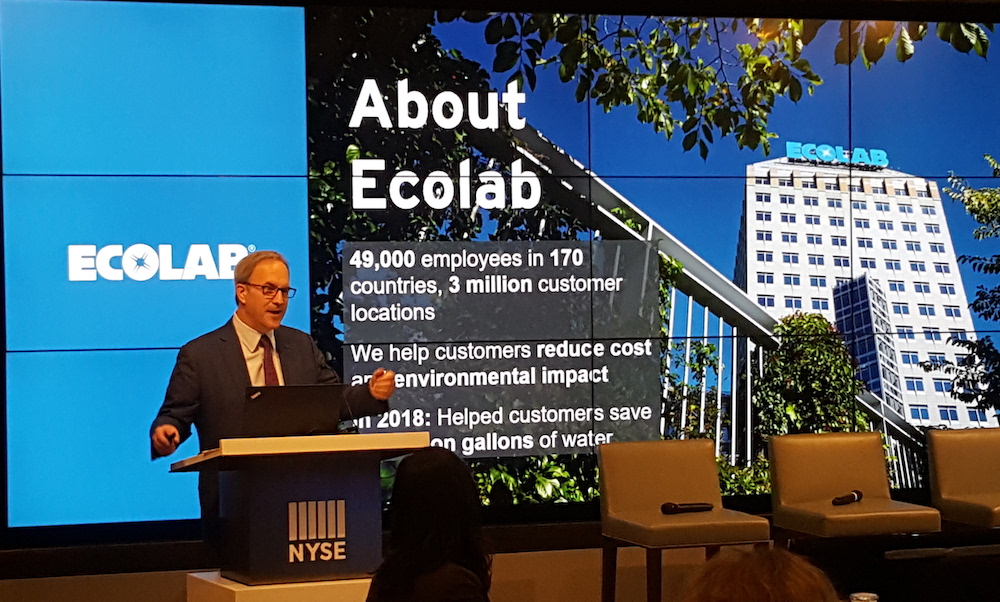
(Photo above: Ecolab Chairman and CEO Douglas Baker, Jr. presents the Smart Water Navigator at the New York Stock Exchange on Thursday.)
Why do companies need a tool like this? They're keen to tell you.
The Smart Water Navigator was developed in collaboration with early adopters of corporate water stewardship, such as global hospitality company Marriott International, paper-based products company Kimberly Clark and beverage giant Coca-Cola. Its features directly address pain points these companies experienced when they created their own water management plans, their executives said in New York this week.
"In the mid 2000s, we wanted to take a stronger stance on corporate water and made an enterprise goal to reduce our water usage," recalled Jim Bath, director of global environmental services for Kimberly Clark. "We went around the world and found the largest users of water in our enterprise, and we worked diligently to significantly reduce their usage." Though these efforts were well-intentioned, the company ultimately discovered they were ill informed: Net water usage declined, but the cuts came in regions that already had plenty of water, Bath explained.
"Our target was a 27 percent reduction by 2015. We made a 28 percent reduction as an enterprise, but we did it in the places where there was the least economic, environmental or social reason to make a water reduction," Bath said. "Reflecting on that ... we decided that we need to focus on water reduction where it matters the most."
To focus reduction efforts in the watersheds most at risk, companies need more data about their operations in water-stressed regions and the means to apply that data at the site level. Complementing existing resources—such as the World Resources Institute's Aqueduct tool, which maps water stress around the world—the Smart Water Navigator can help companies do just that.
Jon Radtke, water sustainability program manager for Coca-Cola, shared a similar sentiment. "We started our [water stewardship] journey well over a decade ago. There was no playbook at that time, so we kind of made it up as we went along," Radtke said. "I wish we had Aqueduct when we started; I wish we had the Smart Water Navigator, because those are exactly the things we’ve been working on for the past decade. I think it will be a lot easier for companies to institute that now."
Water risk data helps companies reduce risk, build value
Unlike other global environmental problems like climate change, water issues vary heavily from region to region, presenting both challenges and opportunities. Although companies must be nimble enough to work within the local context, there's much to be gained by getting it right—in terms of risk aversion, sustainable growth and reputational benefit, executives said.
"Our hotels in South Africa were able to achieve massive reductions because of the [water shortage]. Why can’t we do that before there’s a risk?" Denise Naguib, vice president of sustainability and supplier diversity at Marriott International, asked rhetorically. "It was a very clear signal to the organization that these things can happen and let’s not wait until it happens again. We have an opportunity to go across our portfolio and think about not only the areas that face high water risk today, but also think about how to institutionalize these adjustments."
Additionally, considering consumers' shifting preference toward socially responsible brands, taking action on water stewardship can give companies a competitive advantage. "For a brand like ours, there’s a lot of opportunity in building consumer confidence," said Radtke of Coca-Cola.
More than 70 percent of American consumers say they look for environmentally-friendly business practices when making a purchase, according to a 2019 survey. Radtke described similar findings from Coca-Cola's own research and said water issues are of particular interest. "We’ve done a lot of surveys and asked, 'What would cause you to choose to buy Coca Cola?'" he explained. "We looked at all the sustainability areas around things like recycling and climate, and the one that always comes to the top is restoring watersheds and providing clean water access."
Considering the heavy on-the-ground impact of water stress, these findings aren't surprising. We need water to live, as well as to do business, and during a shortage, all stakeholders—from consumers to industry—feel the pain immediately. "People care about it," Radtke said simply, "and I think there’s a lot of opportunity for companies to improve their reputation through water stewardship."
While not a panacea, tools like the Smart Water Navigator can help companies identify local risks, as well as overarching opportunities, before it's too late. "What we need to do as a collective business community is understand these challenges are coming," Baker of Ecolab said. "Skills aren’t developed from Tuesday to Wednesday. It takes time to develop these processes and understand them."
Image credits: RedCharlie/Unsplash and Mary Mazzoni
Dick's Sporting Goods Ditches Guns Despite Declining Sales


Why is the stock price of DICK'S Sporting Goods trending up, even as sales have slightly declined? The retailer's decision to remove guns from more stores offers a few clues.
Ed Stack, CEO of Dick's Sporting Goods, announced during a recent earnings call that the company will entirely remove guns from the shelves of 125 stores nationwide.
The disappearing firearms will be accompanied by a selection of hunting inventory. The stock is expected to be replaced by an assortment of goods from other sporting categories such as boating and baseball, as well as a few novel features such as indoor batting cages.
The removal of guns from approximately 1/6th of the 729 Dick's Sporting Goods stores is not unprecedented. Last year, Stack made a similar call when he elected to remove assault-style weapons and high capacity magazines from all Dick's stores following the Parkland, Florida school shooting. He further vowed they would never be carried again. At the same time, Dick's changed its policy to restrict sales of any firearms to people over the age of 21.
That decision was met with vehement backlash from the NRA, a revocation of its membership to the National Shooting Sports Foundation and blacklisting from some of the country’s largest gun manufacturers such as Mossberg and Springfield. Many organizations and individuals pledged to boycott Dick's.
The results are in: Dick's has indeed suffered a loss in sales. The last calendar year has put Dick's down 4 percent in total revenue. This coincides, however, with a 12 percent decrease in firearms sales across the nation according to Small Arms Analytics. The slump in gun sales reflects the social and political turmoil surrounding the issue; this trend also helps to validate Stack’s decision to partially divest in guns.
Despite that decline in sales, the company’s stock value has actually increased about 10 percent in the year since the decision to remove assault-style weapons was made. Stores have seen increased foot traffic and other outpourings of support from people happy to finally see a corporation take a public stand on gun control.
That creates an interesting juxtaposition. Stock value increasing while sales decrease is an unusual scenario in well-established businesses. It may, however, become more common as businesses choose ethics over short-term profit. The influence of public perception is more powerful than ever.
Stack would certainly agree. He said, “We are really very, very confident and excited about our business.”
The decision to remove guns from a significant portion of Dick's stores wasn’t made on a whim, nor was it motivated by social pressures. Instead, it’s the result of an experiment that has been taking place since the tragic incident in Parkland.
Firearms were pulled from select Dick's stores in 10 locations over the last year. These pilot stores had historically low gun sales anyway, so their disappearance wasn’t much noticed. Dick's replaced their firearm displays with ski gear and kayaks and swapped out ammunition for shoes.
The results were uniformly positive - increased sales, more foot traffic and more satisfied customers.
These results bode well for Dick's, especially stores in areas with a low population engaged in hunting or sport shooting. Firearms sales vary widely from store to store and tend to be slow-moving inventory. The 125 stores that are dropping guns, while still unidentified, were confirmed to be among the stores that didn’t sell much hunting equipment.
Perhaps that’s just indicative of the times, as the U.S. hunting population continues to dwindle. The shift to selling more apparel and outdoor sporting equipment doubles as future-proofing as well as social-proofing.
As Ed Stack famously said in his letter addressing the Parkland school shooting: “Thoughts and prayers are not enough.” It’s encouraging to see a Fortune 500 CEO both talking the talk and walking the walk.
Image credit: Mike Mozart/Flickr
Investors Rank Airline Leaders, Laggards on Climate Change


The aviation sector has long grappled with rising emissions and their effects on climate change; this investor group recently identified leaders and laggards in the industry.
The newswires are currently preoccupied with Boeing’s woes due to its 737 Max fleet, yet the aviation sector is also grappling with another challenge: rising emissions and their impact on the world’s environment.
Aviation is widely seen as the transport sector that is most difficult to decarbonize, according to the independent nonprofit International Council on Clean Transportation (ICCT). That hasn’t stopped a group of investors from demanding bolder, faster action in a recent ranking of best and worst airlines in combating climate change.
The fast-growing aviation sector accounts for about two percent of global greenhouse gas emissions and aircraft emissions are expected to grow by 50 percent by 2050 as worldwide demand for air travel increases.
That should be more than enough incentive for airlines to prioritize their carbon footprint, but the Transition Pathway Initiative’s (TPI) recent review of 20 of the world’s biggest listed airlines found the industry as a whole was not doing enough to manage climate change. The TPI is backed by investors representing over $13 trillion in assets.
The investor group looked at public corporate disclosures such as CDP for its research. It noted that many airlines have formally adopted industry targets to reduce their net emissions. But that this approach, the Carbon Offsetting and Reduction Scheme for International Aviation (CORSIA), relies on carbon offsetting rather than airlines reducing their own flight emissions.
“Offsetting is no substitute for a clear strategy to reduce emissions,” Helena Viñes Fiestas, Deputy Global Head of Sustainability at BNP Paribas Asset Management, said in a press release.
Nevertheless, TPI did highlight some leaders and laggards out of the pack. Only four airlines—ANA Group, Delta, Lufthansa and United—were strategic in their approach to managing climate change, according to TPI. Five airlines—Air China, China Southern, Korean Air, Singapore Airlines and Turkish Airlines—were at the bottom of the ranking in level of awareness of climate change, the group's researchers said.
United aims for halving its carbon footprint
In an interview with TriplePundit, United’s Aaron Robinson, the airline’s senior manager of environmental affairs and sustainability, cited the company’s focus on fuel efficiency and its investment in sustainable fuels as reasons for its high ranking in the study.
United, the third-largest carrier based in the U.S., has twice been named the Eco-Airline of the Year by Air Transport World. United was also the first U.S. airline to set a greenhouse gas emissions reduction goal for reducing its individual emissions, a 50 percent reduction in carbon emissions by 2050.
“We have also made a commitment to our business customers to have the lowest gross carbon footprint amongst our key competitors,” Robinson told 3p.
United is the largest airline investor – globally – in future sustainable aviation fuel technology, he added. In 2016 it became the first U.S. airline to begin using commercial scale volumes of sustainable aviation fuel for regularly scheduled flights.
Efficiency can secure the bottom line
Along with United, Australia's Qantas and EasyJet, Alaska Air scored well on lowering carbon emissions in TPI’s review. Recognized as the most efficient airline in North America for seven years in a row by the ICCT, Alaska Airlines is the leading U.S.-based airline listed on the 2017 Dow Jones Sustainability Index.
“We believe the most environmental fuel is the fuel we don’t use—thus our continued focus on flying the most-efficient fleet, and pioneering new technology to fly greener and smarter,” Kirk Myers, director of sustainability for Alaska Air, told 3p in an interview.
The commitment to efficiency, he said, “is not only best for our environment, but for our business,” “We’re 13 percent more efficient than the U.S. carrier average, and that means we’re also 13 percent less exposed to the volatility in cost of jet fuel.”
Finding the right incentives
Only Delta and Lufthansa have gone as far as linking their climate change targets to executive pay, for which investors are calling, the study found.
But United pushed back against that conclusion. Jet fuel consumption was United’s second largest cost in 2017, “making United executives and managers incentivized to conserve fuel, reduce GHG emissions and improve the company’s (and their own) financial performance,” Robinson said.
And while the study highlighted that no airline had created an internal price of carbon, Robinson said “as fuel is our #2 expense and accounts for nearly 99 percent of our carbon footprint, there is nothing more topical to United’s bottom line than our price of carbon.”
Making sustainable fuels economically viable
Reliance on sustainable fuels to meet carbon goals is no sure thing, according to experts. Sustainable aviation fuels costs about three times as much for airlines to purchase compared to standard fuel, according to the Rocky Mountain Institute. As a competitive, low-margin industry, airlines have been unwilling to commit to large-scale sustainable fuels consumption at current prices, RMI noted. That means sustainable fuel producers cannot secure project finance to build new bio-refineries, achieve economies of scale and bring prices down.
Despite these challenges, airlines like United and Alaska see sustainable fuels as their best bet to tackle airline emissions. United’s Robinson said the airline plans to purchase nearly one billion gallons of biofuel in the future, all of it sustainably certified and utilizing a waste byproduct – currently either agricultural waste or municipal solid waste.
“The study made no mention of biofuels, which we remain bullish on as one of the most promising methods to reduce our carbon footprint,” Robinson said.
If traditional fuel-based aviation doesn’t move fast enough, it may soon be sharing airspace with electric aviation competitors with its far lower carbon footprint, as 3p has reported. Electric aviation newcomers like Zunum expect to launch their first hybrid electric regional aircraft by the early 2020s, slashing emissions by 80 percent.
Image credit: Pixabay/Skeeze
Why More Supermarkets Are Committing to Zero-Waste


Are supermarkets optimal candidates for incorporating zero-waste practices? With more retailers eliminating plastic packaging altogether, the evidence suggests the answer is a resounding yes.
Baby Boomers were the last generation to experience a milkman as a part of everyday life. But are the principles of circularity that date back to the 1950’s and 1960’s (and even before) coming back? Are supermarkets now optimal candidates for incorporating how we used to shop decades ago?
Nada grocery store in Vancouver, B.C. is proving that, yes, they are. Customers who shop at Nada are committed to zero-waste practices, and this “trend” has significant impacts. As reported in several publications including the Wall Street Journal, Nada, in a single month prevented this much waste from entering a landfill:
-
Food Waste: 259 pounds
-
Plastic Containers: 21,428
-
Paper Cups: 1,228
At first those numbers may not seem overwhelming. But with an estimated 38,000 supermarkets in the United States alone, imagine how much waste could be prevented from going into local landfills.
This one store is a prime example of an uptick in small, local, one-stop, packaging-free stores sprouting up and taking root in many urban areas. These trendsetters, early adapters, globally-minded grocery store entrepreneurs are meeting their customers’ wants and needs while minimizing harm to the planet.
Another hip, package-free store that’s been gaining attention is Precycle in Brooklyn, New York. Founder Katerina Bogatireva says Precycle wasn’t a lightbulb moment, but more like a phototropism - that is, a reaction against our throwaway culture or gravitation to a new idea of how we could store, present and buy groceries. Precycle started to take shape in 2015 when Bogatireva began to clearly see the mounting results as a result of consumerism. Finding ways to reduce waste as much as possible became her central focus.
From Brooklyn to Sicily to Malaysia to South Africa, more zero waste grocery stores are popping up. Websites like Litterless are also emerging online and helping consumers find packaging-free grocery stores.
More consumers are conscious about sustainability
In a recent Nielsen report, 81 percent of global respondents reported feeling strongly that companies should help improve the environment. From pledging to eliminate single-use plastics to using artificial intelligence to develop more sustainable production processes, companies small and large are responding to pressures from consumers and governments to create more responsible solutions.
On average Americans throw away 307 plastic bags per year. But the amount of waste created and percentage of waste being recycled is slowly starting to support more sustainable ideas. In an interesting statistic that shows the share of Americans by age who used reusable grocery bags made from cloth or other materials in order to be more eco-friendly in 2018, it’s not millennials leading the charge, but those with the greatest spending power—people over the age of 50. With several generations now indicating their preferences for more sustainable ideas on how we shop, grocery stores striving to eliminate plastic are on the cutting-edge of this changing consumer trend.
The benefits of eliminating plastic packaging
It’s not just small grocery stores phasing out single-use plastic either. Large grocery retailers are making commitments to more sustainable, plastic-free options as well.
Kroger plans to eliminate plastic bags in its stores by 2025. Big Y recently announced its plans to fully transition to reusable bags by 2020. Whole Foods ended its use of disposable plastic grocery bags in 2008.
For a grocery retailer heavyweight like Kroger, eliminating plastic bags means 6 billion will no longer be distributed. Why is this advantageous? First, these actions increase measures to protect the environment; in addition, taking such steps also satisfy shifting consumer habits.
The next frontier? Taking on the single-use plastic containers that store countless food products, from plant-based protein entrees to nut butters to organic cookies.
Backlash against plastic waste is mounting. More cities and states are banning or imposing fees on plastic bags. And retailers are responding in kind. If the rapid pace at which technology has advanced is any indication of how sustainably-focused consumer habits will evolve in the next decade, then the grocers who are responding are wise to do so. Perhaps in the near future “No Single-Use Plastics” signs will become as standard as the familiar “No Shirt. No Shoes. No Service.”
Image credits: Nada/Facebook
Big Isn’t Beautiful: Why Oil and Gas Investors Should Challenge Executive Pay
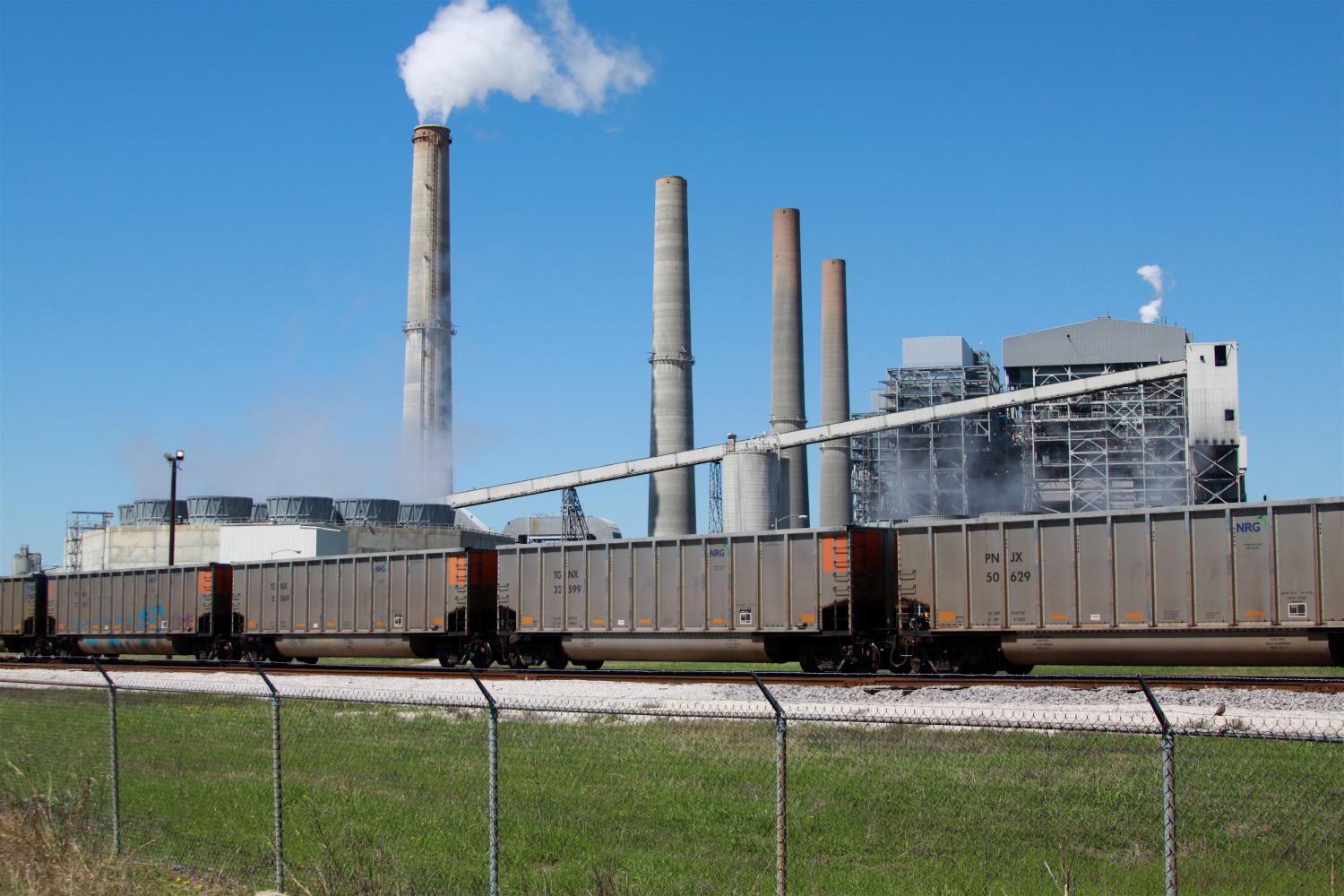
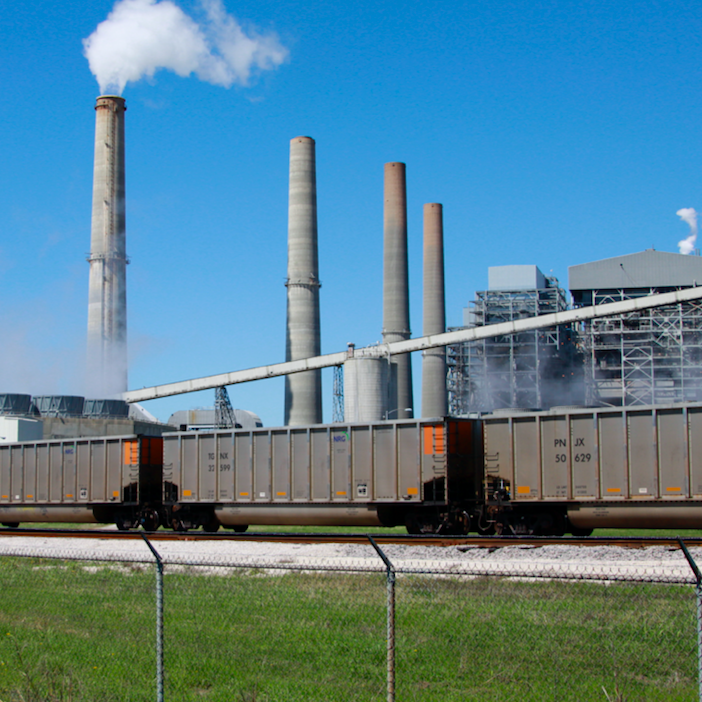
New analysis by Carbon Tracker shows that the more oil and gas executives were incentivized for growth, the worse the returns for their investors in the years following.
Growth simply for the sake of growth is not a desirable attribute in an oil and gas producer. In the boom years of 2010-2014 oil prices were over $100 a barrel yet financial returns actually fell, as the tricky business of maximizing returns to capital came second to the scramble to increase production. Since the crash, the narrative has belatedly changed to “value over volume” and “capital discipline.”
As well as the industry’s own behaviors, there is now the challenge presented by the low-carbon energy transition – the increasing cost-competitiveness of alternatives, such as renewables and electric vehicles, allied with society’s efforts to reduce reliance on fossil fuels in order to mitigate the worst effects of climate change.
This has a couple of dimensions that clash with the growth mindset. First, reduced overall demand for fossil fuels means a smaller pie for producers to battle over, and most producers will have to shrink in absolute terms even if they hope to increase market share.
Second, there are license to operate issues. The latest science has emphasized the harm that will occur even at relatively low warming outcomes, so there is a renewed urgency to act and to be seen to act as a good corporate citizen. It is not enough for companies to just show that they have good operating records; there is increasing call for companies to show that they are “aligned” with the Paris Climate Agreement. Companies seen as pulling in the opposite direction to the rest of the world risk being seen as a lost cause rather than part of the solution.
Executive compensation practices lag behind the rhetoric
None of these factors means that the oil and gas industry needs to turn off the spigots immediately. But together they do imply that producing companies need to reconsider the way they do business. A focus must be on extracting maximum economic benefits from their opportunity sets, rather than relying on ever-increasing consumption of their products. Non-linear outcomes mean that the financial impacts of small shifts in underlying market forces can be significant – oil demand grew by 3 percent over 2014-2016, yet a 2 percent excess of supply resulted in the S&P Global Oil Index falling by 51 percent.
Despite this, the vast majority – over 90 percent of major listed companies in 2017 – of oil and gas producers reward their executives with higher bonuses if they boost production and/or reserves volumes.
In addition to management incentives that reward simple volume additions, there are several other metrics that can support growth in slightly less direct ways. For example, a CEO might decide that the easiest way to hit earnings targets would be to increase leverage and acquire assets that generate income over and above the additional debt service costs. However, that does not mean value has been created for shareholders. New analysis by Carbon Tracker shows that the more executives were incentivized for growth via their 2013 bonus, the worse the returns for their investors in the years following.
Pay structure begins to reflect climate concerns, but ducks the big issue
Concerns about climate change are trickling through into questions of corporate governance and executive pay. Both Chevron and Shell have recently announced that they will link emissions performance to management pay in future years. Chevron’s targets relate to methane emissions and flaring reductions only, whereas Shell’s will include other sources and scope 3 emissions – those produced when using the oil or gas, and by far the bulk of life cycle emissions relating to fossil fuels.
Such incentives to reduce pollution are a good thing, but there remains a more fundamental issue. The “carbon budget” of emissions that can be released while meeting our climate commitments is finite, yet both companies currently encourage their management to continue increasing production of oil and gas. Theoretically, the very lowest cost producers may be able to keep output flat or even increase it while demand falls overall. However, this is likely to only apply to a select number of companies, and other producers will have to cut their production even more to make up the difference. Think day one of statistics class, when the professor asks the class who thinks they will score above average – and every student puts their hand up.
Investor aims are aligned on both value and the environment
The good news is that investors are increasingly pressuring companies to change their compensation approach to more growth neutral metrics that encourage more responsible management focused on the long term. A 2015 shareholder resolution resulted in BP’s remuneration committee agreeing that their target relating to reserves replacement did “not fit with the group’s strategic focus on ‘value over volume,’” and it was accordingly dropped from the company’s 2018 incentive structure. In fact, over a quarter of companies disclosed that they had initiated or increased emphasis on financial returns metrics in 2018 compared to 2017.
Hopefully this trend will continue through the 2019 reporting and annual general meeting (AGM) season, but the persistence and widespread use of such growth incentives means that investors have much further to go in their scrutiny.
Abandoning the pursuit of fossil fuel expansion will involve breaking some deeply ingrained habits. Many got into the industry to make discoveries and build things, and CEOs believe they need to sell a growth story to raise capital. But shareholders do not help themselves by paying management to just produce more fossil fuels – and at the end of the day it does not matter if the motivation is the climate or just the bottom line.
Image credit: Roy Luck/Flickr
CEOs Galvanizing against Gender Equality Backlash
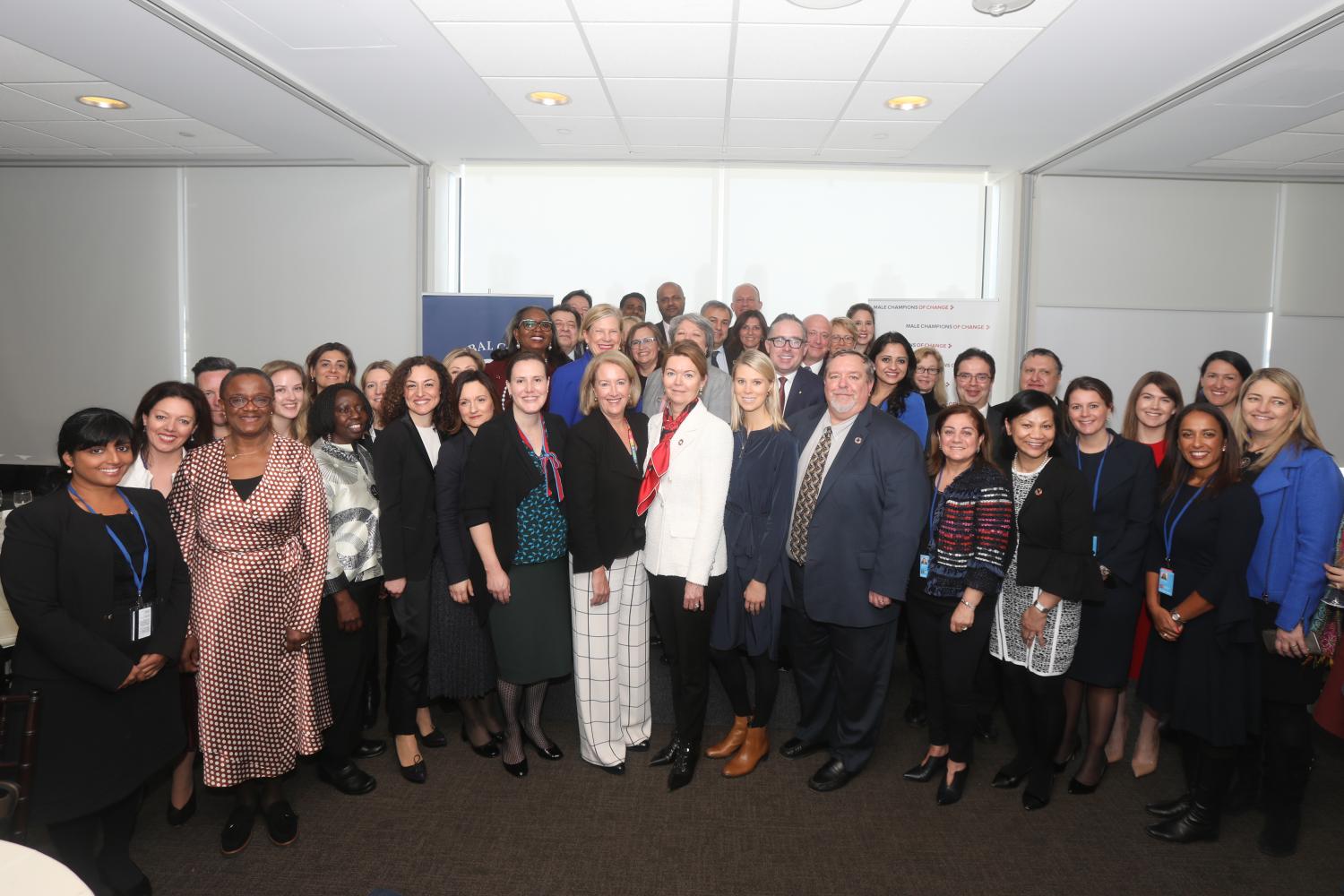
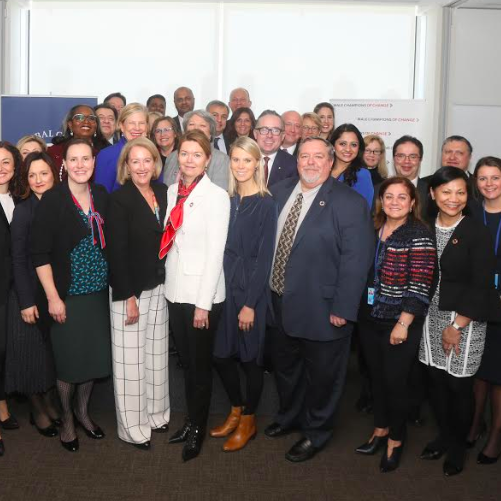
Last week, leaders convened for a CEO roundtable at the UN to find ways to advance gender equality at a time when many efforts to boost diversity confront an ongoing backlash.
Today, leaders from over 20 organizations will convene for a CEO roundtable at the United Nations to strategize on ways to advance gender equality at a time when many efforts to boost diversity and inclusion confront an ongoing backlash.
Among the leaders in attendance, who represent a diverse range of industries including the banking, mining, consumer packaged goods and hospitality sectors, is the UN Global Compact’s executive director, Lise Kingo.
“We can’t afford to take two steps back for every step forward,” Kingo said in an emailed statement to TriplePundit. “Gender equality is not only the right thing to do, but it also makes business sense. As we push for progress, there will be people who push back, shy away or fail to see the value of our action to advance equality. But we must keep moving forward.”
Elizabeth Broderick, Founder and Convener of Male Champions of Change (MCC), echoed that sentiment. “Bringing about change requires perseverance and courage. It also calls for change makers to engage with the range of responses, rather than dismissing the views of those who stand in the way of reform. When we work to understand the reason for resistance we are far more effective in our efforts to achieve significant and lasting change,” she said.
Evidence of a backlash has been witnessed worldwide, ranging from the election of Donald Trump as U.S. President in 2016 and Jair Bolsonaro as Brazil’s leader last fall. In the private sector, examples such as the infamous Google engineer’s screed against the tech giant’s inclusion efforts back in 2017 comprise only the beginning of such a list.
MCC is one organization working with the businesses and governments to ensure diversity and gender parity are part and parcel of their strategic initiatives. The group, which dates back to earlier this decade in Australia, says it partners with various leaders to take a close look at men’s role in reversing gender inequality within the workplace. MCC’s tactics include guaranteeing that companies publicly commit to advance gender equity; identify and deploy high-impact strategies that “disrupt the status quo” in order to foster meaningful change; and ensure continuous follow-up by holding member organizations accountable as they evaluate and share both their experiences and results.
Business organizations that complement the efforts of Global Compact and MCC include the CEO Act!on for Diversity and Inclusion (CEO Action), which launched in 2017. CEO Action boasts over 500 member CEOs and company presidents across 85 industries, as well as educational institutions and associations committed to change how the business community addresses diversity and inclusion. Its goals include the grooming of workplace cultures where all ideas and perspectives are welcomed and encouraged.
Companies that question the value of diversity need to look no further than the CEO of Aflac, Dan Amos. One of his most frequent sayings is that he already aware of what a 60-year-old white man thinks, so there is no reason to surround himself with other 60-year-old white males. Amos has been determined to build a diverse set of leaders at the table whenever critical decisions about the company’s strategy and future are being made. His leadership was among several reasons why Amos was awarded the Lifetime Achievement Award at the CR Magazine Responsible CEO of the Year awards during last year’s 3BL Forum.
The Global Compact has its own response to any outcry over gender diversity efforts. “Such responses often perceive gender equality as a zero-sum game. These concerns are usually underlain by drivers such as lack of understanding, fear, change fatigue, cultural norms and industry norms that contribute to a view that efforts to achieve gender equality have ‘gone too far’.”
Image credit: UN Women/Flickr
This Fashion Brand Is Betting Big on Local Manufacturing

With its sustainability ethos and local supply chain, California fashion label Amour Vert is a case study for cutting social and environmental impact in the apparel industry, without sacrificing style.
As the global middle class continues to rise, clothing production has approximately doubled over the past 15 years, according to the Ellen MacArthur Foundation, and the environmental impact of this segment is growing quickly. If nothing changes by 2050, the fashion industry will comprise more than 25 percent of the global carbon budget under a 2-degree scenario, the Foundation revealed in a 2017 study.
Through its Circular Fibers initiative, the Foundation is calling on the fashion industry to use more sustainable, biodegradable and recycled fibers that cut the carbon footprint of textile production. It's also working with NGOs, governments, and brands like H&M and Nike to divert textile waste from landfills and further reduce impact.
Of course, given the massive scope of the modern fashion supply chain, the emissions associated with textile production and disposal are only the tip of the iceberg. Worth an estimated $2.5 trillion, the fashion industry employs over 300 million people worldwide—more than 60 percent of whom live in developing countries. This not only opens the door for labor abuses in far-flung factories with little brand, government or third-party oversight, but also increases transportation-related emissions and overall carbon footprint.
Crafted in California: A case study in local fashion
With these factors in mind, tackling the impact of the apparel industry at scale requires both sustainable textile innovation and a move toward more localized manufacturing. California-based fashion label Amour Vert is out to prove that both can be done—without sacrificing quality and style. The brand includes French-inspired fashions for men, women and children that are produced with the smallest environmental impact possible.
Located in San Francisco, Amour Vert works directly with textile mills to pioneer new fabrics that are durable and desirable, as well as sustainable. For example, this spring the company will debut new fabrics from its exclusive Tencel and Modal fiber blends, made from eucalyptus and beechwood trees. Both are created in a closed-loop process using sustainable yarns and are biodegradable, according to the company.
One of Amour Vert's key mill partners is located only a few hundred miles south in Los Angeles, allowing the company's designers and decision-makers to play a hands-on role in the fabric development process. "The localization of our LA-based mill partner allows our team to travel back and forth to and meet in person," Aaron Hoey, CEO of Amour Vert, told TriplePundit. "I believe in-person conversations are crucial and allow for creative minds to meld together to create, as well as offer us the ability to touch, feel, and see the softness and drape of the fabrics. We [also] want to manufacture in the Bay Area when possible due to this belief. "
Amour Vert's local manufacturing puts purpose front and center
Collaborating with local fabric mills is only the start for Amour Vert. The company works almost exclusively with small garment manufacturers in Northern California, and 97 percent of its clothing is made within a few miles of its San Francisco office—decreasing carbon emissions and supporting fair labor. "From the start, we have manufactured in the Bay Area when possible because local supply chains and distribution channels have the lowest possible environmental impact," Hoey explained. "Local production means less transportation of clothing, which ultimately means less of a carbon footprint."
As press reports continue to detail the prevalence of human rights abuses within apparel factories, working with local suppliers gives Amour Vert greater control over what happens during manufacturing. "Having our production site so close to our office also means we get to visit the factories regularly, allowing us to closely monitor safe work conditions for our workers," Hoey said.
Having a close relationship with its manufacturers, many of which have worked with the company since its founding in 2010, also allows Amour Vert to push for practices that better align with its sustainability ethos—including natural dyeing, water reduction initiatives and small-batch production that reduces waste.
This collaborative streak extends to partnerships with other local, sustainable brands—including a wildly popular collaboration with Los Angeles denim label AGOLDE. The Amour Vert x AGOLDE collab features LA-made denim made from 100 percent organic and recycled cotton in what Amour Vert calls "one of the only vertically integrated denim production facilities in the United States." Including three cuts and nine washes, the line proved to be a fast hit and was even featured in Forbes as "a collection of jeans that may well be the world's most eco-friendly."
Fashion with a conscience: Sustainability as a brand differentiator
The concept of sustainability as a profit-killer becomes more obsolete each day, as market research continues to show that consumers are seeking brands with a purpose beyond profit. Case in point: Clutch, a Washington D.C.-based research and consulting firm, recently surveyed American consumers to find out what motivates their purchasing decisions—and the results are surprising. More than 70 percent of consumers said they look for environmentally-friendly business practices when making a purchase, compared to only 44 percent who are primarily motivated by price.
Amour Vert has been sustainable from the start, positioning the company well to withstand the shifting consumer attitudes that have left many brands perplexed. "We have found that sustainability is not a hindrance, but rather, a challenge that can lead to a creative process for innovation in creating new fibers and fabrics," Hoey said.
"Customers increasingly want to know that their goods are being made ethically and that they understand the supply chain behind the clothes they’re wearing," he continued. "Amour Vert wants to provide our customers with as much transparency as possible when it comes to our local supply chain. If a client wants to know where their clothes are produced and how they’re being produced, we feel they deserve to know."
The company highlights its factory partners prominently on its website, calling on customers to learn more about who makes their clothes. Amour Vert factory partners include a 23-year textile industry veteran who opened his own shop in Oakland after his previous employer downsized and laid off his colleagues, and a San Francisco factory owner who trains her all-women team one-on-one.
"Sharing the stories of our workers allows our customers to hear firsthand where their clothes are coming from and allows us to highlight designer partners," Hoey said. "Furthermore, we are extremely proud of our all of our partners as they are some of the best factories you can work with from a quality standpoint, so why would we not highlight them?"
Amour Vert's focus on local supply, storytelling and sustainability have brought both prominence and profit—offering a lesson and a case study for other fashion brands. The company rakes in an estimated $14.5 million in revenues each year, according to Crunchbase, and counts celebrities like Blake Lively and Olivia Palermo as fans.
Image credit: Amour Vert
Editor's Note: This story was updated on March 14 to remove reference to members of Amour Vert's team who are no longer with the company.
General Motors' Urban Mobility Service, Maven, Turns Three


As GM’s mobility solution, Maven, turns three, the company's smart cities chief recently spoke with 3p to tell us more about the service and its evolution over time.
Auto manufacturers have been pondering the future of personal transportation for several years. Many of these companies have recognized that disruptive technologies mean the business model of selling cars to the public, the norm for over a century, will inevitably comprise a diminishing part of their revenue streams.
Automakers realize that instead of being car companies, they are increasingly in the business of personal mobility. By taking this broader view, this new reality will open up new business opportunities based on more creative scenario planning. App-based services, autonomous vehicles and micro mobility opportunities are all likely to change the personal mobility landscape going forward.
As a result of this changing environment, General Motors’ executives, musing on the future of mobility, created Maven three years ago. Alex Keros, Maven’s smart cities chief, recently spoke with TriplePundit to tell us more about the service and how it has developed over time.
Maven is GM’s urban mobility solution; the app-based car sharing service allows members to rent a range of GM vehicles by the hour to meet their needs. Options include renting a Chevrolet Bolt electric vehicle for running around town, or reserving an SUV for adventures further afield.
In addition, Maven supports peer-to-peer car sharing as well, whereby owners can rent their personal vehicle to other members when they’re not using it.
Keros told 3p, “the phone becomes the key-fob,” allowing members to locate, reserve and unlock a vehicle for their use, for as little as an hour at a time.
The service represents a bit of a switch for GM, as Keros said the company is “going from the core business of selling $35,000 cars, to $10 transactions.” Meanwhile, GM and Maven are forging personal relationships with their customers as opposed to serving them indirectly through dealer networks.
This shift also alters the demographics of GM’s typical customer. The sharing service is popular on the east and west coasts, where GM is less strong with car sales, as 80 percent of car sharing members are millennials.
Car-share services are not new, of course, and today, Maven would appear not only to have competition with other companies in this space, but also with services like Uber and Lyft; all are vying for the public’s personal mobility dollars.
However, Keros said Maven is not in direct competition with Uber and Lyft, as the company works with these ridesharing companies through Maven Gig.
Maven Gig makes assets available to people working in the gig economy who either drive for e-hailing services, or work for food delivery services such as Grubhub. Keros described this service as “a job in a box,” in that Maven supplies the vehicle and the insurance, for an all-in weekly rental fee. In this way, Keros said the service is complementary to other companies in the gig economy, and for many drivers, Maven Gig is preferable since it alleviates the need for drivers to secure the capital to purchase a vehicle of their own.
Maven Gig also offers the public an opportunity to experience driving in an EV. A key part of Maven’s service is a fleet of over 1,000 Chevrolet Bolt EVs. Keros estimated over 3 million people have ridden in the backseat of a Bolt EV because of Maven.
But beyond providing a useful service, Keros told 3p that with Maven, “the objective is to be a thoughtful corporate citizen by working with cities,” explaining that in collaboration with certain cities in the United States, they have worked to find ways to reduce both congestion and emissions.
For example, Maven has worked with the city of Los Angeles to ensure the service meshes with the city’s Sustainable City Plan, while also collaborating with utilities and infrastructure providers to deploy robust EV charging services.
Similarly, Maven has also worked with the city of Austin, Texas to set up a fleet of 20 Bolt EVs for freelancers working in the gig economy, and in conjunction with the Austin Transportation Department and the Rocky Mountain Institute, aims to create infrastructure solutions leading to an all-electric future.
In the three years since Maven launched, the service currently boasts 208,000 members and now operates in 24 cities in the USA, Canada and Australia.
As to a vision for the future, Keros said Maven remains committed to growing this market sustainably and predicted, “mobility will become much more seamless and flexible,” adding that as people increasingly want to get their side-hustle on, “peer-to-peer platforms are going to become more and more prevalent.”
Image credit: Maven
£1.1 Million Investment Awarded to Maker of Sunglasses from Recycled Plastic


The upmarket eye wear company Karün has received a €1.25m ($1.42m, £1.1m) boost from an ethical investor to continue development of its high-end sunglasses and other products, all of which are made from ditched plastic, particularly fishing gear and other marine debris.
The investment has been made by the Stockholm-based finance consultancy Blue, which funds only ethical companies, believing they “apply human ingenuity to deliver resourceful, sustainable solutions serving as a force for good in society”.
Karün has its administrative center in Patagonia, Chile, and uses a manufacturer in Italy to make its sunglasses.
It provides sunglasses to the award-winning Chilean big wave surfer Ramón Navarro and was the official supplier to the 2017-18 Volvo Ocean Race, the three-yearly round-the world yachting event. The sunglasses were the first choice of star participants Charlie Enright, Martin Strömberg and Mark Towill.
Blue co-founder and chief executive Anders Jacobson said: “Karün shows how entrepreneurs can embed environmental concerns into their business vision as it trailblazes the integration of green practices into its material sourcing and manufacturing that reflect the humanity of its founders and management team.
“[The company] are change-makers who are demonstrating it is possible to solve the problems facing the planet and humanity in sustainable ways.”
Karün founder and chief executive Thomas Kimber said: “Karün sunglasses are symbols of the change we want to see happening in the world by making a positive impact on the environment and local communities.”
Kimber emphasized that, as well as protecting the environment through restoring ecosystems and converting reclaimed plastic into positive products, his company was creating income for Patagonia’s micro-entrepreneurs.
The company has little trouble finding its raw material – abandoned and lost fishing gear comprises ten per cent of the sea’s plastic pollution.